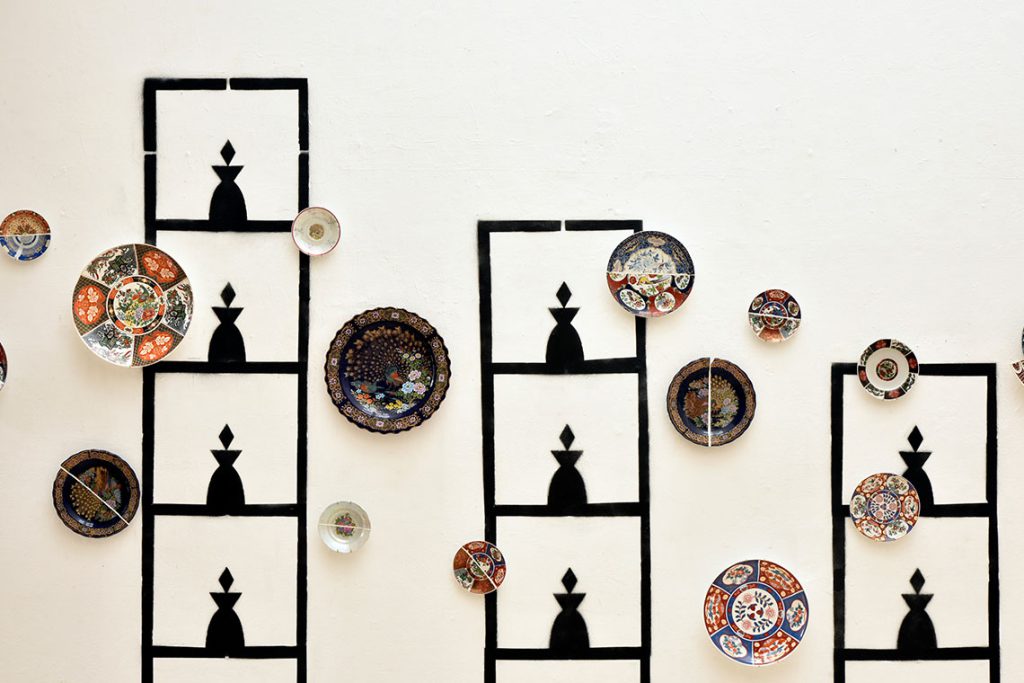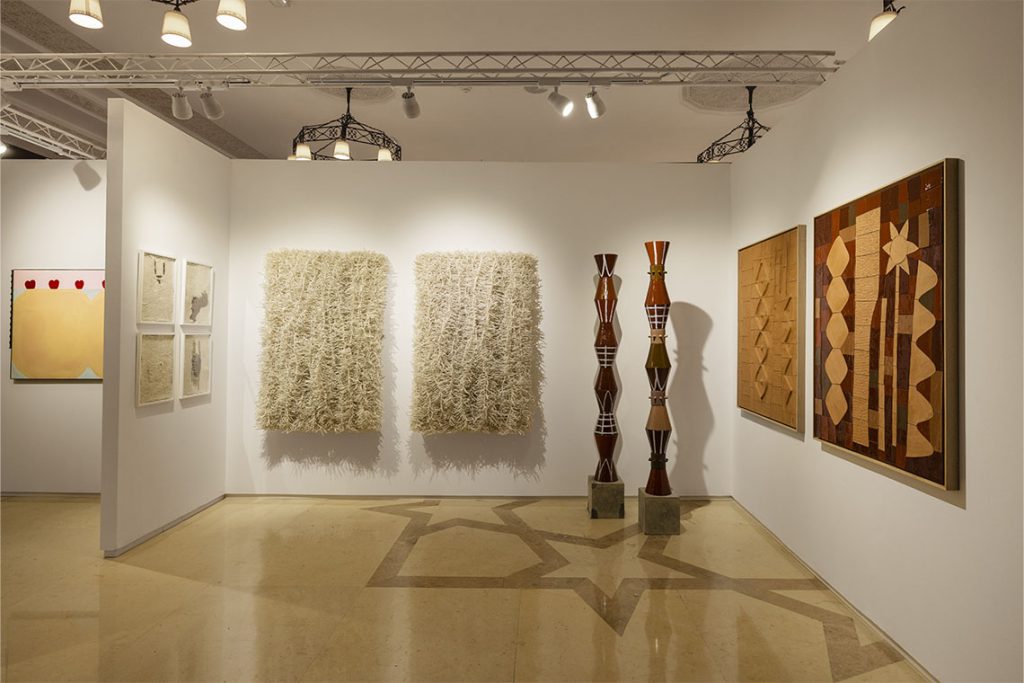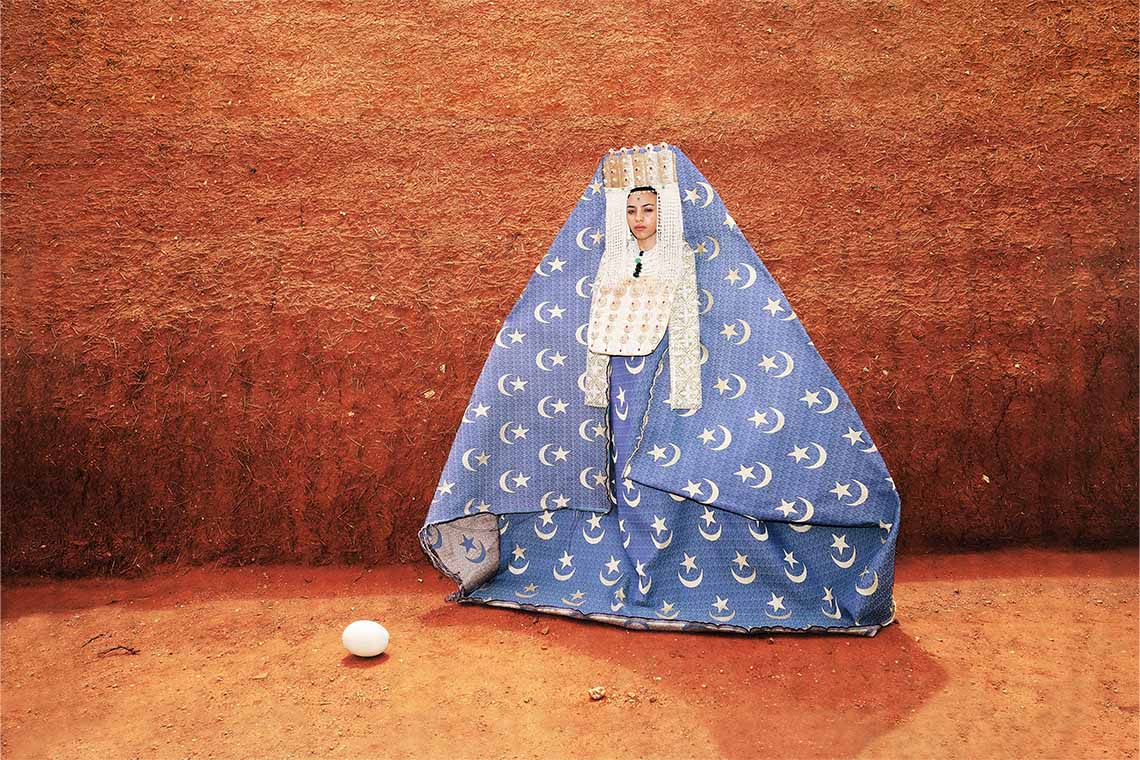As 1-54 Contemporary African Art Fair’s Marrakech sixth edition comes to a close, it’s time to reflect on an intimate fair that opens new possibilities and puts Moroccan art front and centre.
For a few days in the middle of winter, or during what passes for winter in Morocco, the historic city of Marrakech is overtaken by people who flock to the city not so much for its famous attractions but for one of the three yearly iterations of the 1-54 Contemporary African Art Fair.
With other editions taking place in London and New York, often during some of the busiest art business weeks of the year (they coincide with Frieze), the Marrakech fair immediately sets itself apart as a standalone event. Not only that, but with founder Touria El Glaoui hailing from Morocco there is a distinctly more personal feel to the whole proceedings.
Compared to its recent London edition, housed over several floors of Somerset House, 1-54 Marrakech is decidedly smaller and more cosy. Yet its more modest size does not detract from its impact. With 30 galleries spread across two locations – the famed La Mamounia hotel and relatively new multicultural space DaDa – the fair gives extensive insight into the dynamic Moroccan art scene.
The Moroccan galleries, and particularly the younger artists present at the fair, ultimately comprised the beating heart of this edition. The genuine enthusiasm for sharing their artistic practices was noticeable and gave the overall experience a particularly personal quality. Bouchra El Menjra, an emerging Moroccan artist based in Casablanca and represented by Myriem Himmich Gallery, was one of the many artists generously giving visitors further insight into her practice. Her vibrant sculptures (which look like large-scale clock faces) are made from scrap pieces of metal and wood, which she infuses with new life by assembling and painting over them in bright blue, red and pink hues.
El Menjra’s work is a testament to the ingenuity of a new generation of artists who are finding inspiration and material in their local settings while creating pieces with stories physically rooted in their environment. 1-54 Marrakech offers new and interesting channels for expression, with El Menjra remarking to Canvas on the fair’s energy, creativity and ingenuity, as well as the variety of visitors, which she said combined to “make a true space for stimulating exchange and discovery, where one feels a real passion for art is present.”
Myriem Himmich Gallery was one of eight galleries in the DaDa building, separated from the main fair and just off the bustling and mildly chaotic Jemaa el-Fnaa in the heart of the old city and adjacent to the winding alleyways of the world-famous souk. Also at DaDa was a newcomer to 1-54, Hunna Art, which is based in Kuwait. Through a variety of media that included sculpture and painting, Egyptian Amina Yahia and French-Moroccan Maïssane Alibrahimi explored themes of collective and individual behaviour, rituals, identity and gender norms. Founder Océane Sailly explained to Canvas how she had chosen these young emerging artists for their “very distinct, yet complimentary, visual and conceptual grammars that propose fresh and intimate perspectives on these subjects”. She also remarked that the DaDa space, which focuses on showcasing rising stars on the art scene, “allowed for an intimate and focused setting, fostering meaningful exchanges about their practices. So far, they have generated a lot of interest and enthusiasm, with real connections forming between the audience and the work”.

Another must-see at DaDa was CDA Gallery, based in Casablanca, which provided a compelling glimpse into what the next best things on the Moroccan art scene might be. A standout work by Amine Asselman was a series of traditional Moroccan zellige tiles, with an unusual greenish-blue glazed hue – the result of complex chemical experimentation by the artist – used to achieve the particular shade and markings of each piece. The enduring power of an age-old craft combined with Asselman’s artistry showcased how, in Morocco, the modern and traditional can combine to create uniquely local pieces.
An ingenious initiative saw a series of tuk-tuks shuttle visitors between DaDa and La Mamounia, the iconic upscale hotel set a little further out from the Medina and which housed the main part of the fair. The larger selection of galleries and more formal feel struck an immediately different tone from the more relaxed DaDa. Here was a sense of a traditional and corporate art fair, with the array of booths focused more on doing business, albeit among the beauty and comparative peace of the location. The 22 galleries present in this section of the fair were almost all immaculately curated, mercifully free of the excess and visual overload that has become synonymous with some other art fairs. 1-54 Marrakech and its participating galleries seemed to have neatly sidestepped the pitfalls of trying to show too much, opting instead for smaller selections of quality pieces. As in DaDa, the presence of several participating artists ready to engage with visitors added a welcome overall warmth.
Now in its fifth year, the Prix Mustaqbal by the Morocco-based Fondation TGCC, was founded to promote and support contemporary art. This year the prize was awarded to a selection of monochromatic works by seven artists exhibiting at the fair. Particular standouts were the black-and-white photography of Yassine Sellame, whose Chemistry Act series experiments with chemical intervention over film photographs to produce unexpected results, and Mehdi Ait El Mallali’s incredibly dark and atmospheric landscape photography entitled Essences Tangibles, showcasing how innovative approaches that depart from the accepted rules of photography as a medium can achieve fascinating results.

In a similar vein, the reliably excellent work of young Moroccan artist Sara Benabdallah was also on display with Paris-based Nil Gallery. Benabdallah’s vibrant and modern imagery contrasts with the traditional elements of her work, which seeks to honour the artist’s heritage and defy stereotypes of Moroccan society. The resulting photographs ultimately embody just what 1-54 Marrakech is about: a space where tradition and modernity coexist and merge under the talented gaze of emerging artists from the region.
One of the most polished presentations at this year’s fair was by Loft Gallery, which has gained widespread recognition in recent months with a booth at Art Basel Paris dedicated to Mohamed Melehi and a presentation by Amina Agueznay at Untitled Art Miami Beach. While a solo exhibition by contemporary Moroccan photographer Mous Lamrabat runs in the gallery’s main Marrakech location, Loft’s fair booth featured a selection of works by Nassim Azarzar, Samy Snoussi, Bouchra Boudoua and Amina Agueznay to weave a dialogue around issues such as the transmission of heritage, memory and shifting identities.
Even with the many international galleries presenting an impressive diversity of work by artists from across the African continent (including 1-54 newcomer space Un, a Japanese gallery exhibiting a solo presentation by Senegalese artist Aliou Diack), the strong presence of Moroccan artists as the core of the fair was inescapable. For those looking for a broader overview of the contemporary African art scene the Marrakech event may not be as richly informative as 1-54’s other editions, but as a snapshot of one of the Maghreb’s most flourishing art scenes it is out on its own. With international attention continuing to intensify on the creativity, achievements and potential of Morocco’s artists, then the unusually insightful art fair experience offered by 1-54 Marrakech is uniquely valuable.
1-54 Contemporary African Art Fair: Marrakech ran until 2 February



